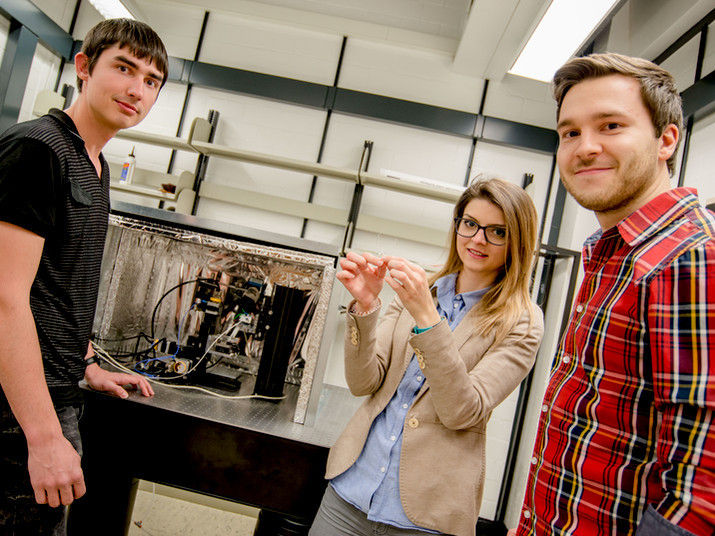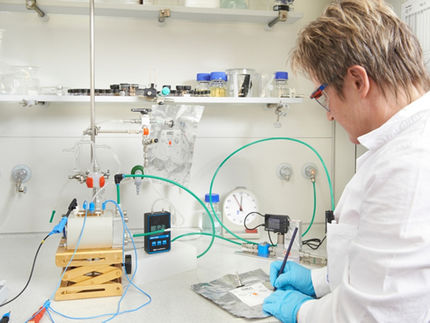Robust and inexpensive catalysts for hydrogen production
hydrogen gas is considered a possible future source of energy and can be produced from water using platinum catalysts and electricity. However, alternative catalysts made of cheaper and more readily available materials with equally high efficiency are barely known.

The team from Bochum in the laboratory: Tsvetan Tarnev, Corina Andronescu and Mathias Smialkowski (from the left).
© RUB, Marquard
Electrodes without precious metals
There are a number of materials that, like platinum, are able to catalyse the reaction of water into hydrogen. "These include metal chalcogenides such as the mineral pentlandite, which is just as efficient as platinum and is also significantly more stable towards catalyst poisons such as sulphur", explains Ulf-Peter Apfel. Pentlandite consists of iron, nickel and sulphur. Its structure is similar to that of the catalytic centres of hydrogen-producing enzymes found in a variety of sources, including green algae.
A drop with a diameter of only a few hundred nanometres
In the current study, the researchers investigated the hydrogen production rates of artificially prepared crystalline surfaces of the mineral pentlandite in a drop of liquid with a diameter of a few hundred nanometres. They used scanning electrochemical cell microscopy for this purpose.
This enabled them to clarify how the structure and composition of the material influence the electrocatalytic properties of iron-nickel sulphide. Even the smallest changes in the ratio between iron and nickel by varying the synthesis conditions or the ageing of the material considerably changed the activity in the electrochemical hydrogen formation. "With these findings, we can now continue to work and develop strategies to improve many more robust and cheap catalysts", says Ulf-Peter Apfel.
Design principles for electrodes
The researchers also showed that scanning electrochemical cell microscopy makes it possible to link information on the structure, composition and electrochemical activity of the materials in a spatially resolved manner. The method thus makes it possible to design catalysts specifically and to produce highly active materials this way. "In future, this method will therefore play an important role in the search for electrocatalytically active, heterogeneous catalysts", says Wolfgang Schuhmann.
Original publication
Cameron L. Bentley, Corina Andronescu, Mathias Smialkowski, Minkyung Kang, Tsvetan Tarnev, Bernd Marler, Patrick R. Unwin, Ulf-Peter Apfel und Wolfgang Schuhmann; "Die lokale Oberflächenstruktur und -zusammensetzung bestimmt die Wasserstoffevolution an Eisen-Nickelsulfiden"; Angewandte Chemie; 2018
Cameron L. Bentley, Corina Andronescu, Mathias Smialkowski, Minkyung Kang, Tsvetan Tarnev, Bernd Marler, Patrick R. Unwin, Ulf-Peter Apfel und Wolfgang Schuhmann; "Local Surface Structure and Composition Control the Hydrogen Evolution Reaction on Iron Nickel Sulfides"; Angew. Chem. Int. Ed.; 2018
Original publication
Cameron L. Bentley, Corina Andronescu, Mathias Smialkowski, Minkyung Kang, Tsvetan Tarnev, Bernd Marler, Patrick R. Unwin, Ulf-Peter Apfel und Wolfgang Schuhmann; "Die lokale Oberflächenstruktur und -zusammensetzung bestimmt die Wasserstoffevolution an Eisen-Nickelsulfiden"; Angewandte Chemie; 2018
Cameron L. Bentley, Corina Andronescu, Mathias Smialkowski, Minkyung Kang, Tsvetan Tarnev, Bernd Marler, Patrick R. Unwin, Ulf-Peter Apfel und Wolfgang Schuhmann; "Local Surface Structure and Composition Control the Hydrogen Evolution Reaction on Iron Nickel Sulfides"; Angew. Chem. Int. Ed.; 2018
Topics
Organizations
Other news from the department science

Get the chemical industry in your inbox
By submitting this form you agree that LUMITOS AG will send you the newsletter(s) selected above by email. Your data will not be passed on to third parties. Your data will be stored and processed in accordance with our data protection regulations. LUMITOS may contact you by email for the purpose of advertising or market and opinion surveys. You can revoke your consent at any time without giving reasons to LUMITOS AG, Ernst-Augustin-Str. 2, 12489 Berlin, Germany or by e-mail at revoke@lumitos.com with effect for the future. In addition, each email contains a link to unsubscribe from the corresponding newsletter.



























































